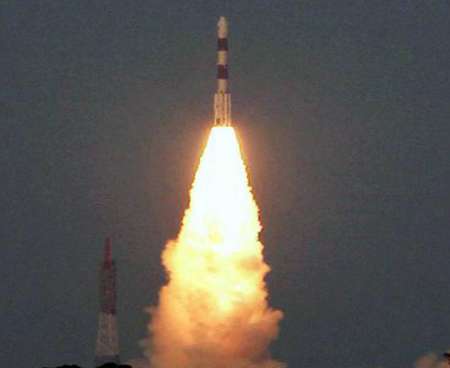ID :
323275
Sat, 04/05/2014 - 16:37
Auther :
Shortlink :
https://oananews.org//node/323275
The shortlink copeid
India Successfully launches 2nd Navigational Satellite

New Delhi, April 4, IRNA -- India Friday successfully launched its second navigational satellite IRNSS-1B onboard PSLV C-24, taking a step closer to realising its ambitious programme of establishing an independent regional space-based navigation system.
IRNSS-1B, the second of the seven satellites planned under the Indian Regional Navigation Satellite System (IRNSS), was placed in precise orbit by the workhorse Polar Satellite Launch Vehicle (PSLV) which completed its silver jubilee success mission.
Drawing a golden brush in the clear blue sky, the 44.4 metre tall PSLV-C24 lifted off from the Satish Dhawan Space Centre in Sriharikota in Andhra Pradesh State, about 100 km from Chennai, today evening and soared to its destination, pti reported.
About 19 minutes after the lift-off, PSLV C24 successfully placed the 1,432 kg IRNSS 1B in the intended orbit above the Earth, much to the jubilation of the ISRO scientists in the mission control room.
ˈThe PSLV, in its 25th successive successful flight, precisely injected Indiaˈs second regional navigational satellite IRNSS-1B very precisely,ˈ an elated ISRO chief K Radhakrishan said.
At a total budget of around Rs 1,420 crore, ISRO is in the process of putting in place the IRNSS, comprising a space, ground and user segments, which would provide accurate position information service to users in India as well as the region extending up to 1500 km from its boundary.
IRNSS is equivalent to Global Positioning System of the United States. IRNSS-1A, the first satellite of the IRNSS constellation, has already started functioning, having been launched in July last year.
Thanking the entire ISRO team for this ˈmajor milestoneˈ for the country, Radhakrishnan said ˈFor the farthest distance we targeted was 20,650 kms plus or minus 20,675 kms, and what we got is 20,630 kms, just 20 kms less. As far as the inclination of the orbit, we are on the dot.ˈ
Talking about the future projects, he said, during the current year the space agency would launch two more navigational satellites IRNSS 1C and 1D.
While the USˈ Global Positioning System (GPS) and Russiaˈs GLONASS are the effective navigation systems worldwide presently, India is hoping to put all the seven satellites in space by 2015. However, the IRNSS could start functioning even with a minimum of four navigation satellites in space.
IRNSS would help in terrestrial, aerial and marine navigation, disaster management, vehicle tracking and fleet management, integration with mobile phones, mapping and geodetic data capture and others.
Meanwhile, intending to study the stars and other celestial bodies in the space, Indian Space Research Organisation (ISRO) is developing Astrosat, a smaller version of Hubble Space Telescope.
ˈAstrosat is nearly getting ready and it would be unique with three aspects -- UV rays, visible and X rays. Even Hubble does not have this aspect. Though Hubble is big, Astrosat will be a small one,ˈ Kiran Kumar, Director, Space Application Centre, Ahmedabad told reporters.
While the optics of Hubble was 2.4 metre diameter, Astrosat would have a optical diameter of 300 mm, he said.
ˈThe satellite is being developed and it is likely to be launched sometime next year,ˈ he said, flanked by ISRO Chairman K Radhakrishnan and other senior scientists. /end





